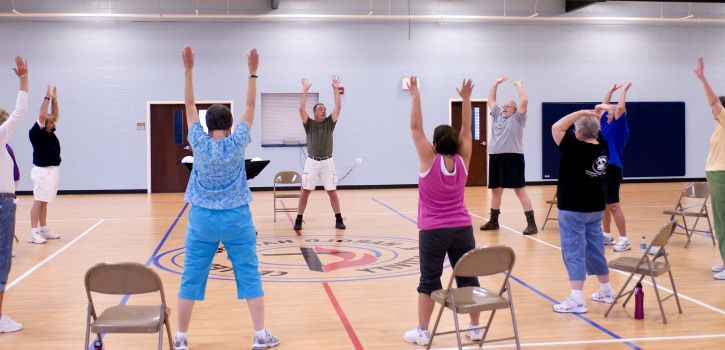A lot of senior citizens have problems with stability. This is because if you aren’t stable and able to maintain your balance well, you are more likely to fall.
For seniors, falling is dangerous because with weaker bones and joints, serious injuries are likely. Fortunately, there are a number of things that seniors can do to improve stability.
Listed below are 5 ways that a senior citizen can improve stability :
1. Stretching Exercises
Stretching exercises help to increase the range of motion in joints which can ease the pain of arthritis. In turn, this can stabilize your joints and improve your overall stability. Like balance exercises, there are plenty that you can do that don’t require any equipment.
2. Balance Exercises
An excellent way to improve your stability at any age is to regularly engage in balance exercises. There are quite a few balance exercises to choose from that will help you strengthen the right muscles so that you can walk with more confidence and stability.
Some balance exercises will require you to use various pieces of exercise equipment such as dumbbells and balance balls, but others don’t need anything other than your body. That makes it easy to do balance exercises no matter where you are!
3. Activity
The old adage that “if you don’t use it, you’ll lose it” is true when it comes to how active you are. If you want to maintain and improve your stability, you need to stay active and keep using your whole body. This will help you in more ways than just improving stability.
Staying active as a senior can also help you avoid common conditions that the elderly often face such as osteoporosis, arthritis, and heart disease. If you are overweight, getting more active will help you lose weight which will improve your overall health condition.
4. Good Shoes
You would be surprised at what a good pair of shoes can do for your stability. In fact, the right pair of shoes could make the crucial difference between walking easily and risking falling just by making a trip from the couch to the fridge.
Good shoes provide stability because they give you a flat surface to walk on and plenty of cushion so you have some room for error when you place your foot down. They will also make walking around significantly more comfortable which reduces foot, knee, hip, and even back pain associated with poor foot support.
5. Walking Aids
Ask your doctor if a walking aid is right for you to help improve your stability. He or she will be able to prescribe you the right level of assistance when it comes to walking aids. For some people, these walking aids are only temporary help that can improve stability by allowing you to be more active as you build up your muscles to be able to walk unassisted again.
If you’re a senior and concerned about your stability, then get started on following these tips today to be able to keep enjoying your life!
Please take one moment to share this post on at least one of the following : Facebook, Twitter, Google + or on Pinterest ! Thanks for the favor !
For seniors, falling is dangerous because with weaker bones and joints, serious injuries are likely. Fortunately, there are a number of things that seniors can do to improve stability.
Listed below are 5 ways that a senior citizen can improve stability :
1. Stretching Exercises
Stretching exercises help to increase the range of motion in joints which can ease the pain of arthritis. In turn, this can stabilize your joints and improve your overall stability. Like balance exercises, there are plenty that you can do that don’t require any equipment.
2. Balance Exercises
An excellent way to improve your stability at any age is to regularly engage in balance exercises. There are quite a few balance exercises to choose from that will help you strengthen the right muscles so that you can walk with more confidence and stability.
Some balance exercises will require you to use various pieces of exercise equipment such as dumbbells and balance balls, but others don’t need anything other than your body. That makes it easy to do balance exercises no matter where you are!
3. Activity
The old adage that “if you don’t use it, you’ll lose it” is true when it comes to how active you are. If you want to maintain and improve your stability, you need to stay active and keep using your whole body. This will help you in more ways than just improving stability.
Staying active as a senior can also help you avoid common conditions that the elderly often face such as osteoporosis, arthritis, and heart disease. If you are overweight, getting more active will help you lose weight which will improve your overall health condition.
4. Good Shoes
You would be surprised at what a good pair of shoes can do for your stability. In fact, the right pair of shoes could make the crucial difference between walking easily and risking falling just by making a trip from the couch to the fridge.
Good shoes provide stability because they give you a flat surface to walk on and plenty of cushion so you have some room for error when you place your foot down. They will also make walking around significantly more comfortable which reduces foot, knee, hip, and even back pain associated with poor foot support.
5. Walking Aids
Ask your doctor if a walking aid is right for you to help improve your stability. He or she will be able to prescribe you the right level of assistance when it comes to walking aids. For some people, these walking aids are only temporary help that can improve stability by allowing you to be more active as you build up your muscles to be able to walk unassisted again.
If you’re a senior and concerned about your stability, then get started on following these tips today to be able to keep enjoying your life!
Please take one moment to share this post on at least one of the following : Facebook, Twitter, Google + or on Pinterest ! Thanks for the favor !




